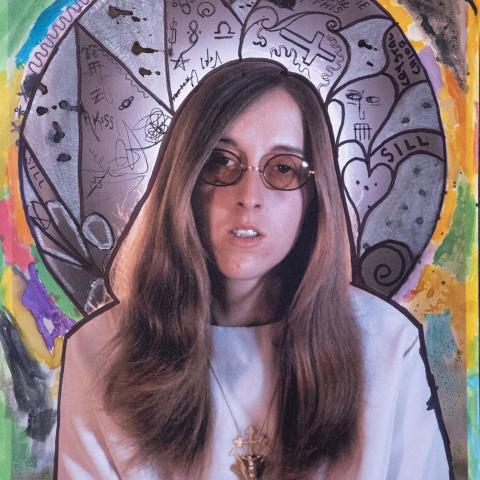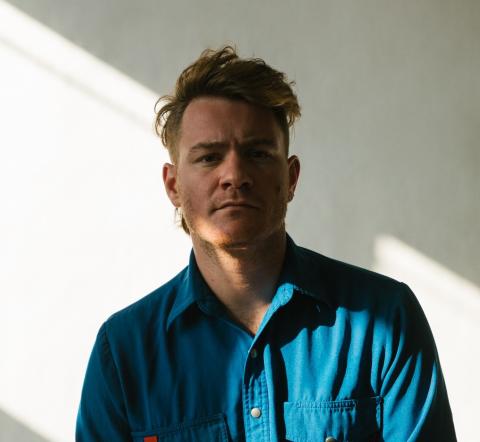Interview Song/Video Premiere: Lorenzo Wolff Explores Judee Sill’s Legacy With “Crayon Angels

February 2, 2021 Hannah Means Shannon
The name “Judee Sill” is very evocative, even if you’ve only heard of her in passing conversations or references, but approaching her early 70s released music more directly only adds to the mysterious sense that she evades any simplistic images we may conjure of her. For those who have delved into her biography, they are aware that she was a remarkable composer and performer, but had a mass of contradictions at work in her life, including a difficult upbringing and the drug addiction that eventually ended her life far too soon. Those struggles stand in contrast and relationship to her ethereal and groundbreaking music, created at a time when a “woman with a guitar” was not allowed well-rounded expression in her work.
Musician and Producer Lorenzo Wolff set to work to create a tribute album to Judee Sill that is, in some ways, as unusual as Judee herself, and will arrive from StorySound Records on March 12th, 2021. Creating new arrangements and interpretations for seven of her songs, each brought to life by a different vocalist, has revealed a full spectrum of genres and possibilities latent in Sill’s own compositions. These surprising and exciting directions shed new light on Sill’s own multi-faceted nature during a time when, thankfully, her work is receiving increased attention. Today, Americana Highwaysis delighted to debut the second single featuring vocals by Grace McLean, “Crayon Angels,” from Down Where The Valleys Are Low: Another Otherworld for Judee Sill, as well as the striking video for the song created by experimental filmmaker Lewis Klahr. Lorenzo Wolff also spoke candidly with us about Judee Sill’s life and work, as well as the inspiration behind this new approach to “Crayon Angels,” below.
Americana Highways: I was aware of the medieval associations with Judee Sill’s work, but when I looked and listened more closely, I was really amazed by what I could hear in terms of lyrics and in terms of musical traditions, like Gregorian chant and Plain song. And that seems to especially apply to “Crayon Angels” and this new version on the tribute album.
Lorenzo Wolff: “Crayon Angels,” specifically, has samples from these secret female rites. The Margaret Berry contribution is “keening,” something that Scottish women do, traditionally at funerals. The other sample that is in the middle of the song is an old African American song that women sang to their daughters. It’s called “No Room in the Inn,” so there are these two parallel, secret female rites that I felt lucky to get to contemplate. Judee has always felt so occult, and the secrets are so close to the surface in a way that gives me a way into those things and connecting with them, as an outsider.
AH: It’s definitely the kind of music where you listen to it, and you wonder if you are interpreting it “correctly” in some official sense, or not. You’re aware that you should go with your personal reaction, but at the same time, you wonder, “Am I really turning the key on this?”
LW: Yes, for sure. For me, that’s what kept me listening to her music again and again. Upon first hearing Judee Sill’s music, for me, it felt like psychedelia. I didn’t really listen hard enough to the lyrics and it felt like traditional 70s, out-there, California music, but the more you listen to it, the more detailed and almost confessional it is.
AH: In terms of making this album, I heard that you were attempting to separate the mythology from the woman. That suggests that there is a strong mythology about Judee. How would describe that myth?
LW: There are probably at least a couple of different versions of how people interact with Judee Sill. There are rabid fans, firstly, who know everything about her, and she’s kind of a cult figure. They know everything about her life and experience, and her music feels like an escape or another world that she’s built for herself to them. When you know her backstory, you can hear that her music doesn’t seem to have a lot of the dirt and the horror that a lot of her life seems to include, based on reading biographies.
Then, there are people who listen to it, and to them it seems kind of like occult Carly Simon. If you don’t know her story, it’s easy to have that experience of her music of traditional instruments presented in a neoclassical way, which she made into a beautiful thing. And hearing it that way is great, too. But for me, I think the more that I learned about her and listened to the music, the more I felt that there was something deeper about the way in which she was presenting this “other world”. It was both autobiographical and something that avoided what her life was actually like. When you talk about turning the key to a song, you never know what someone is thinking. She died very young and didn’t do a lot of interviews, but in the interviews that exist, she is not soft-spoken, sweet, or gentle, but often the music is. My interpretation, on this album, is what would the Judee of interviews be like making a record, versus the Judee that exists on the wax? It’s a sort of true biography through her own songs.
AH: That’s a really cool way of thinking about it. What did you feel like you needed to do to be able to approach this project? Or were you already steeped in her life and music?
LW: I’d been a fan of hers for a long time. I’d been listening to her music for about ten years and I’d always loved it. I’d send the record Heartfood to people, if I really liked them. It was something I was letting them in on, something we’d share together. As opposed to a playlist, I’d send it to people I cared about to see what they thought about it. But I found that I had a very different interpretation of her music than other people I knew. Initially, it was just a production experiment for me. I did the song, “Down Where The Valleys Are Low.” I wanted to see if the songs could handle more aggression or a bigger, more bombastic feel. And it worked so well that I started doing more songs, and also going deeper into her way of thinking, her life story, and my interpretation of where those two things collided in her art.
AH: That touches on a question I wanted to ask you: What was it about the songs that made you think that they could handle this reinterpretation without losing their identity? I do think these new songs preserve the core of the original songs very well.
LW: I think that when, in 1971 and 1973, when these two records came out, there was a pretty small range of roles that a woman who wrote songs could inhabit. Siouxsie Siou hadn’t come out yet, though Mahalia Jackson was plenty aggressive. But for white women with acoustic guitars, there wasn’t really an outlet for that. Judee’s music feels like it was right on the edge of that to me. Even though it’s acoustic guitars, sweet harmonies, and Bach chord changes, it feels like Proto-Punk to me in the way that she delivers it, or at least Proto-Big Star. It feels like it’s right on the edge of an explosion, so my experiment was to see if I could light the fuse a little bit.
AH: I’m so glad that you said that, because I felt, listening both to her music, and then to this album, that you were posing the question: What would have happened if she had continued into the 1980s?
LW: Yes, and there are any number of things, including her own addiction and the people around her, who kept her from doing that. She didn’t ever have an easy road, it seems. But who knows what would have happened. Maybe Blackheart would have picked her up, or Eyeball. Then she would have had an Emo Screamo resurgence in the early aughts. It is inspiring to me, though, that when I talk to people about this project, many more people know who she is now than did ten years ago. Early on in my fandom, when I’d send the record to people, no one would have heard of her. And now, though she’s not a household name, if you’re someone who digs in crates, you’ve come across Judee Sill or someone has recommended her to you.
AH: When you approached the different vocalists who worked on this album, were they already in the know about Judee Sill, or did you get to watch their first encounters with the music?
LW: For “Crayon Angels,” Grace McLean is such a scholar of all things that relate to femininity and the occult, that Judee Sill had long ago come across her desk. But there were other people who had never heard of her and others who had heard of her but never interacted with her music. The side men seemed to know her stuff more, like Jeremy Gustin, the drummer. There were a number of singers who I approached about this project, and often the big Judee Sill fans were horrified by the idea. I can see how they might find it offensive because things like “Crayon Angels” are such a departure. But the music so completely holds up to it and thrives in the rougher treatment.
AH: It should have occurred to me that big fans might be upset, but actually it didn’t. It seems like this new album could be two things: A route to discovery for those who haven’t encountered Judee’s music before, or something interesting to think about for big fans. It highlights her role as a composer and also her significance in music history to make this new album.
LW: I’m excited to have those conversations with people, though. As I was going through the project, I had crises of faith, wondering why I should exert my viewpoint on this woman who I don’t know, but the more I interacted with it, and the more I worked on it, the more encouragement I felt. The more research I did on Judee Sill, the more there seemed to be a Star Wars-style projection in the room, like Obi-Wan, saying, “Go fuck yourself, but this is okay.” I tried to listen to my idea of who she was while I was making it, to make sure that I wasn’t forcing her songs and her visions into something unnatural.
AH: I hear you on that. It seems to me that she was very open to combining traditions and sounds in unusual ways, and that gives a kind of thematic resonance to combining the elements of these existing songs in new ways, too. That’s just my take.
LW: Absolutely. Even ideologically, the lyrics have all these different faiths and perspectives, and that’s why you can’t call Judee Sill’s music Christian music or praise songs. Because in the music, the Devil is kind of sexy, and there are Eastern philosophies as well as out-there 60s occult stuff. She’s such a polyglot thematically, as well as musically. It seems like she had huge ears and a really open mind about so many things.
AH: How did you choose these seven songs to reinterpret?
LW: I did maybe five or six others that I didn’t end up releasing, which exist in various stages of completion, but it seems like these seven were the most complicated, thematically. There was more room for interpretation in these seven songs, which made it feel like she had laid the blueprint for exploring other worlds in these songs. There are other hit songs that people love, like “Loping Along Through The Cosmos,” but it doesn’t seem as broad in its range of interpretations. Likewise, “Enchanted Sky Machine.” Also, when you’re collaborating with singers, you want to leave a certain range of possibilities for them to experience and explore for themselves.
AH: To return to “Crayon Angels,” I can definitely see how the original song has a lullaby feel, and in the new interpretation, I hear that Proto-Punk feel we were talking about earlier. The video both emphasizes that Proto-Punk potential, I feel, and also reminds us that this song originated in the 70s, too. It’s an interesting duality.
LW: Lewis Klahr, who directed the video, asked before he started working on it if it was okay to take it in a 70s direction, or whether I wanted it to be more modern. I left it up to him because I am such a fan of his work, and I figured that anything he could interpret would either be more interesting or a different perspective on the song from what I already had. It was really nice to be surprised by what he made. He used photos from a bus stop in the 70s in California that he had clipped out and had in his studio, sitting there for years. The juxtaposition is very cool to me, with the retro-looking video and the slightly more modern-sounding song.
AH: It suggests so much in terms of different avenues to approach the song. The advertising imagery and the darker suggestions work well together. Often the photos and ads from that period look so pretty and clean-cut, but we know that human life is not usually like that. Especially with someone like Judee, we know there were other elements in her life. The video is a great tightwire act of not giving too much away about Judee’s life, while also suggesting that things may not be what they seem.
LW: There are some little easter eggs in the video, too, for those who know about Judee’s life. If you see the woman in the car with the revolver, you may think, “Maybe that’s related to her robbing liquor stores.” I think Lewis got pretty deep in his research of Judee and presented images that are not at all accidental when they seem to relate to her life. One element I hadn’t thought of, which Lewis included, was the idea of Vietnam Vets returning home during this time and feeling disillusioned. It was Lewis’ interpretation of one of the possible meanings of that song, and it’s really cool to see that coming out in the video.
Read the full article HERE


